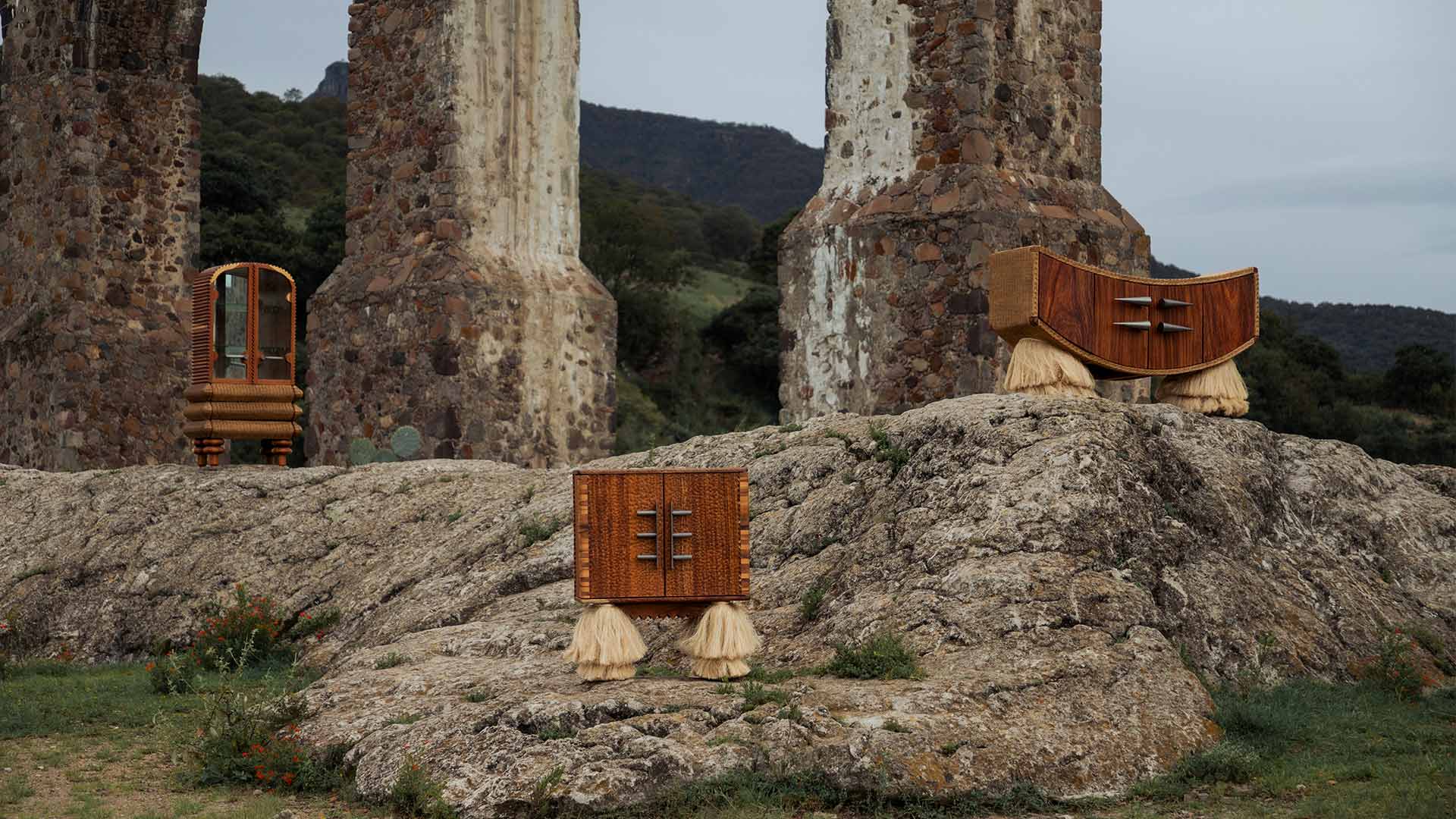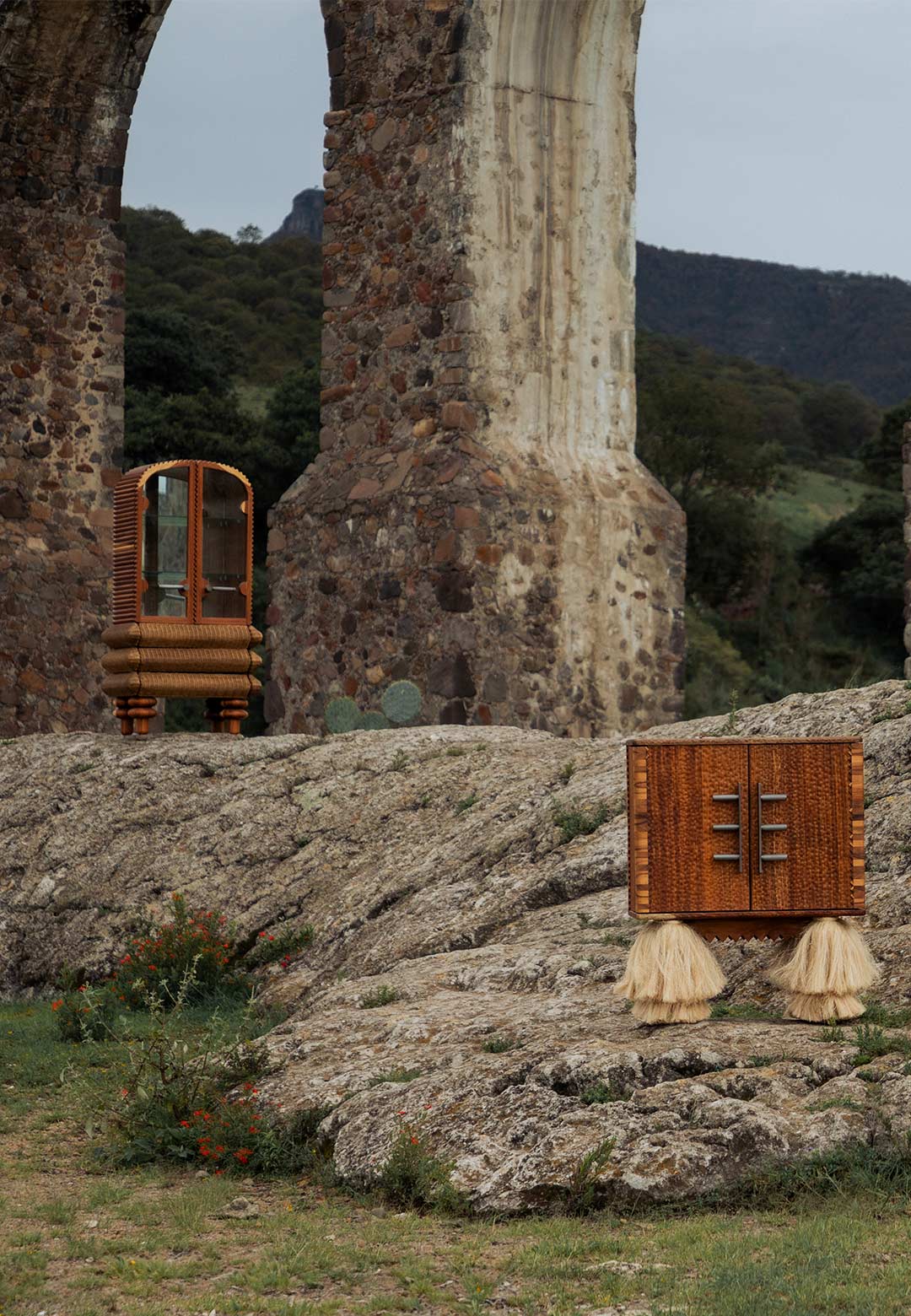Vilma, Carmen and Ramón are animated sculptural cabinets designed and built by Comité de Proyectos, a design studio based in Mexico City. The studio, founded in 2014 by Andrea Flores and Lucía Soto, deals in the practice of interior design and furniture design. Revealing their ethos and process, the designers share, “What we enjoy most about our work is translating emotions and sensations into utilitarian objects and living spaces; that is, internalisation. We like to create transcendent, durable and timeless pieces, with a contemporary style working hand in hand in collaboration with craft workshops.” The Mexico-based studio’s works are a flawless balance of functional stipulations and poetic inspirations. They are built employing traditional craftsmanship techniques, albeit in a minimalist mien, so as to fit better in contemporary markets.
Vilma, Carmen and Ramón, too, are built using a similar idea and technique. Flores and Soto cite the simple acts of caring and being cared for, as the idea that guided the concept of this collection. The designers elucidate their inspiration through the words of Joan Claire Tronto and Berenice Fisher: “Care is a specific activity that includes everything we do to maintain, contain, and repair our 'world' so that we can live in it as well as possible.” The design of the three cabinets emerged after Flores and Soto’s reflections on violence. The two designers wanted to sensitise the manner in which each one of us can relate to each other, to other sentient beings and non-animate entities around us.
When asked how the three furniture pieces embody the act of caring, whilst countering the consumer culture, the designers share, “They are three storage pieces, so literally they keep, they take care of valuable things. But, more metaphorically, each one of them embodies in itself care, the amount of detail and handwork needed to make the pieces reflects care, as well. We used materials that evoke the maternal, such as woven rattan, which we remember as a material mostly used for baskets seen in our grandmother's houses. The idea with these pieces is to care for them as if it were a loved one. Our idea is to question the boundary between an object and a person, because objectifying people is what we believe causes violence, so these pieces remind us of the importance of caring for one another. All of our pieces are made to last, we love the idea of objects transcending time, so our furniture is not for use and throw. When asked about a suitable station for placing the cabinet collection, the designers shared, “We picture them in a Hacienda or in a hotel in Asia.”
Although the concept behind the making of Vilma, Carmen and Ramón is not apparent in the design and form of the cabinets, the ideas of caring and valuing objects beyond their functional usage is made apparent in the manner they are crafted, in the traditional techniques employed to make them, and their intended longevity. The careful usage of materials subtly conveys the idea that resources extracted from nature need to be handled with care, instead of being exploited. “Western culture considers the human being as an entity separate from the environment and the environment as something hostile from which we need to defend ourselves and which we can exploit to obtain resources necessary for our survival. lf we transfer this to the relationship between people, under the lens of capitalism the value of people is measured in terms of their productive capacity. From this same place, we believe that gender violence emerges which dehumanises us through stereotypes,” the studio shares.
The designers assert that such a vision sits in contrast against pre-Hispanic Latín American cultures, wherein the environment and human beings are viewed as parts of a larger whole and have reciprocal roles and responsibilities. Inspired by such a dichotomous culture, the product designers decided to work around the idea of care. “When one cares, one weaves an intimate relationship with the other that transcends one's own needs. Our collection is an ode to the act of caring and we do so through these ornate characters,” the designers share. This is only fitting for the studio since Comitē De Proyectos is founded on the values of communication, respect and equity.
The three cabinets, named Ramón, Vilma and Carmen, respectively, are envisioned upon unique character sketches. “We use ornaments to adorn our characters and generate a contrast between the warm and the cold,” the designers share, referring to the usage of soft fibres and sturdy metals to shape the pieces. While the name Vilma means ‘the protector,’ Carmen is a popular name that was used during the Revolution of Mexico in 1910, the same decade in which Flores and Soto’s grandmothers were born. Ramón, on the other hand, is the masculine version of Ramóna, which references Comandante Ramona, an indigenous Tzotzil woman and commander of the Zapatista Army of National Liberation in Chiapas, Mexico. The choice of using a masculine version of the name was made to attribute the act of caring to men, which stands in contrast to the conventional gender stereotypes.
Carmen, a bar cabinet, comprises a pair of drawers for storing objects, a designated space for storing bottles, compartments for glasses, and cup holders. Once the doors of the cabinet are opened, they reveal pockets on the door for storing smaller glasses. The bar cabinet is made using solid Huanacaxtle wood (a tropical wood that is very soft), and comprises carbon steel fittings. The bottom of the cabinet is covered with a mirror and its wooden legs are covered with sisal fibre, which was moulded using steam to obtain the desired form. The surface of the cabinet is chiselled with a unique texture, obtained by tapping a mallet on its surface.
Ramón, a credenza, is a horizontal storage unit. Its distinct concave form gives it a humorous appearance. The credenza has four doors, which house a pair of drawers and shelves. Its doors, too, are made of Huanacaxtle wood, and its body is covered with rattan fibre. Like Carmen, its legs are covered with sisal fibre. “During the experimentation process, we discovered a texture formed by vertical stripes generated by striking the wood with the head of a metal file. We decided to apply this technique to create the captivating weave on Ramón’s doors,” the designers share. The corners of the furniture are left exposed, leaving behind a peculiar elbow shape.
Vilma, a vertical display cabinet, comprises two main portions—a drawer unit covered with rattan fibre and the upper storage compartment made using Huanacaxtle wood. The back of the cabinet is fitted with a mirror, hence enhancing its visual depth. The drawers on the bottom half of the cabinet can be opened and closed by means of the push system.
All the materials are acquired from a different supplier and different areas in Mexico City, all of whom are experts in their respective crafts. The carpentry was worked upon in a workshop located in Iztapalapa, the ironwork was made in Ducolab, and the natural fibres were woven by a family workshop called Rattan in the south of Mexico City. In using the rattan weaving technique, which is employed by indigenous people of Central America, as well as materials such as the Ixtle fibre, which is a Mesoamerican fibre commonly used to manufacture ropes and textiles by the indigenous population, Comitē De Proyectos manages to honour age-old traditions and practices. “We were inspired by the Zapatista women, a group of indigenous women from Chiapas- in the southeast of Mexico who have organised themselves to protect their customs and their communities. They represent the strength, courage, bravery, beauty, deep love, and dignity that we want to transmit through these pieces,” Flores and Soto elaborate. Made with a great deal of care and respect, the three cabinets hold the capacity to compel their owners to regard the furniture pieces as artefacts for posterity, and not as temporary pieces of furniture meant to be discarded at a later time.






 Sign in with email
Sign in with email










What do you think?